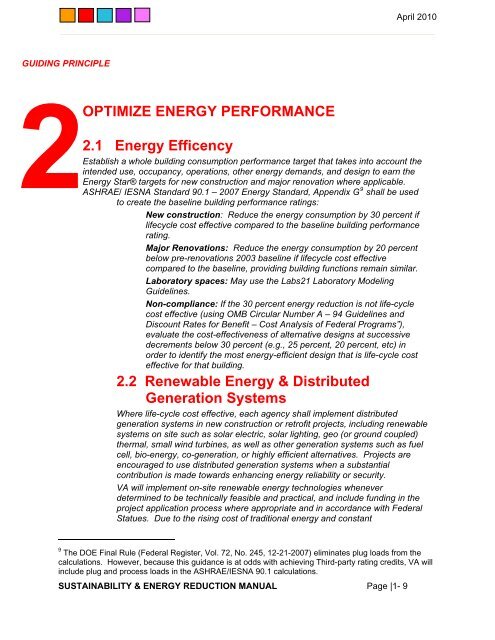Sustainability Design and Energy Reduction Manual - The Whole ...
Sustainability Design and Energy Reduction Manual - The Whole ...
Sustainability Design and Energy Reduction Manual - The Whole ...
Create successful ePaper yourself
Turn your PDF publications into a flip-book with our unique Google optimized e-Paper software.
April 2010<br />
GUIDING PRINCIPLE<br />
OPTIMIZE ENERGY PERFORMANCE<br />
2.1 <strong>Energy</strong> Efficency<br />
Establish a whole building consumption performance target that takes into account the<br />
intended use, occupancy, operations, other energy dem<strong>and</strong>s, <strong>and</strong> design to earn the<br />
<strong>Energy</strong> Star® targets for new construction <strong>and</strong> major renovation where applicable.<br />
ASHRAE/ IESNA St<strong>and</strong>ard 90.1 – 2007 <strong>Energy</strong> St<strong>and</strong>ard, Appendix G 9 shall be used<br />
to create the baseline building performance ratings:<br />
New construction: Reduce the energy consumption by 30 percent if<br />
lifecycle cost effective compared to the baseline building performance<br />
rating.<br />
Major Renovations: Reduce the energy consumption by 20 percent<br />
below pre-renovations 2003 baseline if lifecycle cost effective<br />
compared to the baseline, providing building functions remain similar.<br />
Laboratory spaces: May use the Labs21 Laboratory Modeling<br />
Guidelines.<br />
Non-compliance: If the 30 percent energy reduction is not life-cycle<br />
cost effective (using OMB Circular Number A – 94 Guidelines <strong>and</strong><br />
Discount Rates for Benefit – Cost Analysis of Federal Programs”),<br />
evaluate the cost-effectiveness of alternative designs at successive<br />
decrements below 30 percent (e.g., 25 percent, 20 percent, etc) in<br />
order to identify the most energy-efficient design that is life-cycle cost<br />
effective for that building.<br />
2.2 Renewable <strong>Energy</strong> & Distributed<br />
Generation Systems<br />
Where life-cycle cost effective, each agency shall implement distributed<br />
generation systems in new construction or retrofit projects, including renewable<br />
systems on site such as solar electric, solar lighting, geo (or ground coupled)<br />
thermal, small wind turbines, as well as other generation systems such as fuel<br />
cell, bio-energy, co-generation, or highly efficient alternatives. Projects are<br />
encouraged to use distributed generation systems when a substantial<br />
contribution is made towards enhancing energy reliability or security.<br />
VA will implement on-site renewable energy technologies whenever<br />
determined to be technically feasible <strong>and</strong> practical, <strong>and</strong> include funding in the<br />
project application process where appropriate <strong>and</strong> in accordance with Federal<br />
Statues. Due to the rising cost of traditional energy <strong>and</strong> constant<br />
9 <strong>The</strong> DOE Final Rule (Federal Register, Vol. 72, No. 245, 12-21-2007) eliminates plug loads from the<br />
calculations. However, because this guidance is at odds with achieving Third-party rating credits, VA will<br />
include plug <strong>and</strong> process loads in the ASHRAE/IESNA 90.1 calculations.<br />
SUSTAINABILITY & ENERGY REDUCTION MANUAL Page |1- 9

















